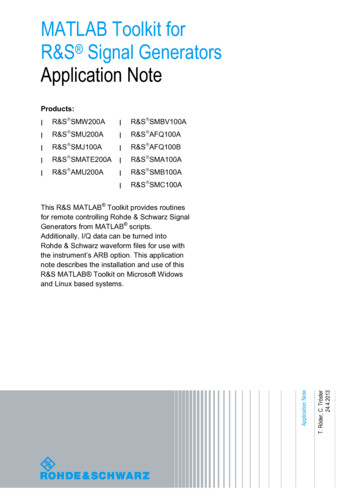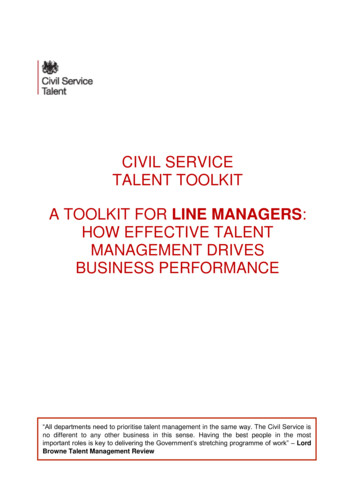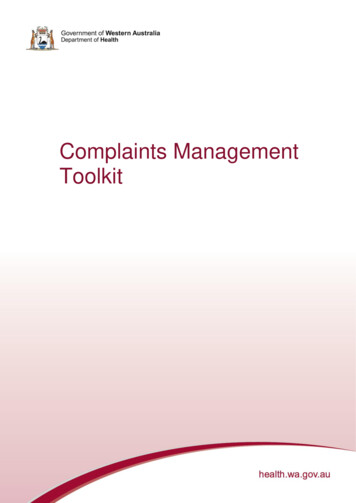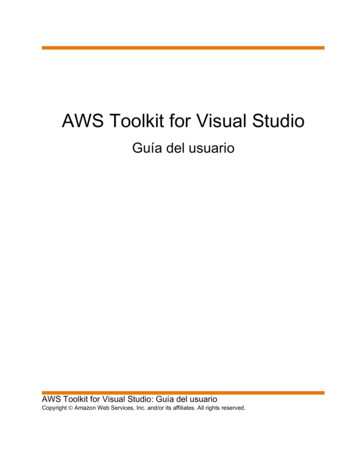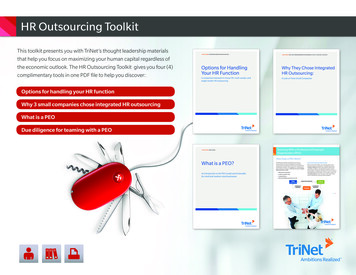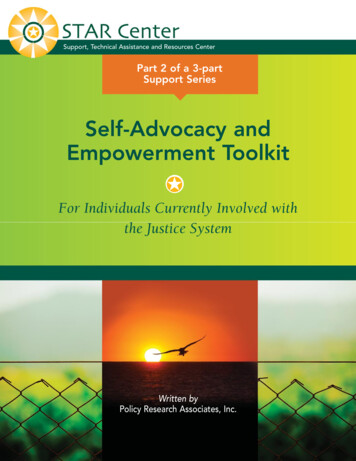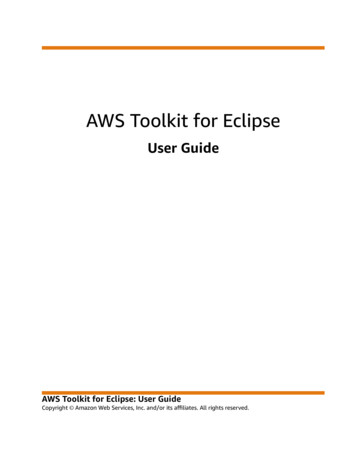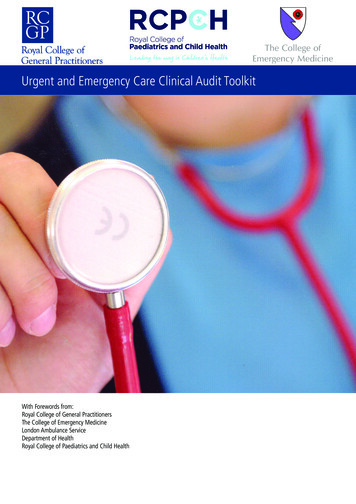
Transcription
SAFETYMANAGEMENTTOOLKITSafety Management Toolkit1
Safety Management ToolkitPlease noteThis information is for guidance only and is not to be taken as an expression of the law. It shouldbe read in conjunction with the Work Health and Safety Act 2012, the Work Health and SafetyRegulations 2012, codes of practice, and any other relevant legislation. You can find this at theWorkSafe Tasmania website at www.www.worksafe.tas.gov.auThis guide was produced by staff from WorkSafe Tasmania.We welcome your feedback on this guide. Send to: wstinfo@justice.tas.gov.auAcknowledgementsWorkSafe Tasmania acknowledges that this Safety Management Toolkit is based on material,information and guidance from:¼¼Safe Work ional Labour Organisation/www.ilo.org¼¼Public Liability Insurance Online/www.publicliability.net.au¼¼South Australian Department of Education and Child Development/www.decd.sa.gov.auSafety Management Toolkit1
ContentsIntroduction. . . . . . . . . . . . . . . . . . . . . . . . . . . . . . . . . . . . . . . . . . . . . . . . . . . . . . . . . . . . . . . . . . . . . . . . . . . . . . . . . . . . . . . . . . . 4About the laws. . . . . . . . . . . . . . . . . . . . . . . . . . . . . . . . . . . . . . . . . . . . . . . . . . . . . . . . . . . . . . . . . . . . . . . . . . . . . . . . . . . . . . . 5Start with a safety policy . . . . . . . . . . . . . . . . . . . . . . . . . . . . . . . . . . . . . . . . . . . . . . . . . . . . . . . . . . . . . . . . . . . . . . . . 7Work Health and Safety Policy. . . . . . . . . . . . . . . . . . . . . . . . . . . . . . . . . . . . . . . . . . . . . . . . . . . . . . . . . . . . . . . . . 9Bullying Policy. . . . . . . . . . . . . . . . . . . . . . . . . . . . . . . . . . . . . . . . . . . . . . . . . . . . . . . . . . . . . . . . . . . . . . . . . . . . . . . . . . . . . 11Drug and Alcohol Policy . . . . . . . . . . . . . . . . . . . . . . . . . . . . . . . . . . . . . . . . . . . . . . . . . . . . . . . . . . . . . . . . . . . . . . . . 12Contractor Safety Management Form. . . . . . . . . . . . . . . . . . . . . . . . . . . . . . . . . . . . . . . . . . . . . . . . . . . . . . 14Take 5 Pre-Start Safety Checklist. . . . . . . . . . . . . . . . . . . . . . . . . . . . . . . . . . . . . . . . . . . . . . . . . . . . . . . . . . . 17Introducing new workers to your workplace. . . . . . . . . . . . . . . . . . . . . . . . . . . . . . . . . . . . . . . . . . . . . 18Induction Acknowledgment. . . . . . . . . . . . . . . . . . . . . . . . . . . . . . . . . . . . . . . . . . . . . . . . . . . . . . . . . . . . . . . . . . . . 20Consultation. . . . . . . . . . . . . . . . . . . . . . . . . . . . . . . . . . . . . . . . . . . . . . . . . . . . . . . . . . . . . . . . . . . . . . . . . . . . . . . . . . . . . . . . 21Record of Consultation/Staff/Toolbox Meeting . . . . . . . . . . . . . . . . . . . . . . . . . . . . . . . . . . . . . . . 23Managing your work health and safety. . . . . . . . . . . . . . . . . . . . . . . . . . . . . . . . . . . . . . . . . . . . . . . . . . . . 24Sample Work Environment and Facilities Checklist. . . . . . . . . . . . . . . . . . . . . . . . . . . . . . . . . . . 32Slips, Trips and Falls Checklist. . . . . . . . . . . . . . . . . . . . . . . . . . . . . . . . . . . . . . . . . . . . . . . . . . . . . . . . . . . . . . . 37Electrical Checklist. . . . . . . . . . . . . . . . . . . . . . . . . . . . . . . . . . . . . . . . . . . . . . . . . . . . . . . . . . . . . . . . . . . . . . . . . . . . . . 382Safety Management Toolkit
Chemicals Checklist. . . . . . . . . . . . . . . . . . . . . . . . . . . . . . . . . . . . . . . . . . . . . . . . . . . . . . . . . . . . . . . . . . . . . . . . . . . . . 39Machinery and Equipment Checklist. . . . . . . . . . . . . . . . . . . . . . . . . . . . . . . . . . . . . . . . . . . . . . . . . . . . . . . 40Manual Tasks Checklist. . . . . . . . . . . . . . . . . . . . . . . . . . . . . . . . . . . . . . . . . . . . . . . . . . . . . . . . . . . . . . . . . . . . . . . . 41Security Checklist. . . . . . . . . . . . . . . . . . . . . . . . . . . . . . . . . . . . . . . . . . . . . . . . . . . . . . . . . . . . . . . . . . . . . . . . . . . . . . . . 42Cutting Tools Safety Checklist. . . . . . . . . . . . . . . . . . . . . . . . . . . . . . . . . . . . . . . . . . . . . . . . . . . . . . . . . . . . . . . 43Preventing Falls Checklist. . . . . . . . . . . . . . . . . . . . . . . . . . . . . . . . . . . . . . . . . . . . . . . . . . . . . . . . . . . . . . . . . . . . . 44Forklift Truck Checklist. . . . . . . . . . . . . . . . . . . . . . . . . . . . . . . . . . . . . . . . . . . . . . . . . . . . . . . . . . . . . . . . . . . . . . . . . 45Managing Noise. . . . . . . . . . . . . . . . . . . . . . . . . . . . . . . . . . . . . . . . . . . . . . . . . . . . . . . . . . . . . . . . . . . . . . . . . . . . . . . . . . . 47Hazard report form. . . . . . . . . . . . . . . . . . . . . . . . . . . . . . . . . . . . . . . . . . . . . . . . . . . . . . . . . . . . . . . . . . . . . . . . . . . . . . . . 49Chemical Register. . . . . . . . . . . . . . . . . . . . . . . . . . . . . . . . . . . . . . . . . . . . . . . . . . . . . . . . . . . . . . . . . . . . . . . . . . . . . . . . 50Emergency Procedure. . . . . . . . . . . . . . . . . . . . . . . . . . . . . . . . . . . . . . . . . . . . . . . . . . . . . . . . . . . . . . . . . . . . . . . . . . . 51Incident reporting. . . . . . . . . . . . . . . . . . . . . . . . . . . . . . . . . . . . . . . . . . . . . . . . . . . . . . . . . . . . . . . . . . . . . . . . . . . . . . . . . 52Training. . . . . . . . . . . . . . . . . . . . . . . . . . . . . . . . . . . . . . . . . . . . . . . . . . . . . . . . . . . . . . . . . . . . . . . . . . . . . . . . . . . . . . . . . . . . . . . 55Sample Training Register. . . . . . . . . . . . . . . . . . . . . . . . . . . . . . . . . . . . . . . . . . . . . . . . . . . . . . . . . . . . . . . . . . . . . . . 56Sample Competency Register. . . . . . . . . . . . . . . . . . . . . . . . . . . . . . . . . . . . . . . . . . . . . . . . . . . . . . . . . . . . . . . . 57Further information. . . . . . . . . . . . . . . . . . . . . . . . . . . . . . . . . . . . . . . . . . . . . . . . . . . . . . . . . . . . . . . . . . . . . . . . . . . . . . . 58Safety Management Toolkit3
IntroductionAre you a small business?Small business often finds it hardest to manage work health and safety. Injuries occurring in smallbusiness are the most costly: over 22,600 more each claim than those of medium and big business.However, work health and safety isn’t just about saving money and protecting your business. It’s aboutprotecting your workers and ensuring they go home the same way as they come to work — free frominjury or illness.Health and safety is a good thing. It’s good for you, your workers and your business.Start thinking about safetyIt doesn’t have to be difficult: just look at the skills, resources and experience you have available atyour workplace and draw on them. You also have the WorkSafe Health and Safety Advisory Service forhelp and practical advice.About the WorkSafe Health and Safety Advisory ServiceThe goal of the WorkSafe Health and Safety Advisory Service is to help you manage health and safety inyour workplace, by offering free information and support.This toolkit is a great way to start, and an advisor can visit your workplace and show you how to applythe resources in your workplace.About this ToolkitThis Safety Management Toolkit is aimed at employers and owners in small business — now knownas Person Conducting a Business or Undertaking (PCBU), which is explained more in this Toolkit. It willalso be useful for managers.By following the steps in this Toolkit and applying them to your business, you’ll be off to a good start toa safer, healthier and more successful business.All sample templates are on the Advisory Service’s web pages. Go to the WorkSafe Tasmania websiteat www.worksafe.tas.gov.au and search for ‘safety advisors’.“We had a near fatality in our workplace several years ago.The person concerned has a serious injury that will be with them for therest of their life and that is something I feel very guilty about. I shouldhave dealt with OHS a long time ago, but in the scheme of things it didn’tseem relevant and, to be honest, I didn’t have the time. Today things aremuch different, health and safety is part of all our operations. It’s not aproblem at all and I know I have done all I can, as an employer, to makesure no one gets injured on my watch” — Employer, transport industry4Safety Management Toolkit
About the lawsIn this section, you’ll learn:¼¼about the work health and safety laws and codes of practice¼¼about PCBUAbout the lawsYou may have heard the new Work Health and Safety Act and Regulations 2012 are lengthy. This istrue — because they contain a lot of specific and clear requirements for controlling certain hazards.The regulations set out the step-by-step process of reducing risks arising from these hazards.Familiarising yourself with the Regulations and codes of practice that relate to your work will help youcomply with the laws.About the codes of practiceThe Act and Regulations are supported by many codes of practice. These are good, user friendly guidesdesigned to de-mysitify the Regulations, and help you manage health and safety issues. They containeasy to use checklists and practical examples of how to manage risks.The codes of practice include (but are not limited to):¼¼How to Manage Work Health and Safety Risks¼¼Managing the Work Environment and Facilities¼¼Work Health and Safety Consultation, Co-operation and Co-ordination¼¼Hazardous Manual Tasks¼¼First Aid in the Workplace¼¼Managing the Risks of Falls at Workplaces¼¼Managing Noise and Preventing Hearing Loss at Work.Using the codes that relate to your work will help you comply with the laws.These and the other codes can be found at the WorkSafe Tasmania website.Go to www.worksafe.tas.gov.au and search for ‘codes’. Over time, further codes will be developed, socheck the website regularly.What does ‘reasonably practicable’ mean?The duty of care is qualified by the test of reasonably practicable.Reasonably practicable means that which is (or was at a particular time) reasonably able to be done toensure work health and safety, taking into account and weighing up all relevant matters including:¼¼the likelihood of the hazard or the risk concerned occurring, and¼¼the degree of harm that might result from the hazard or the risk, and¼¼what the person concerned knows (or ought reasonably to know) about the hazard or risk and aboutways of removing or reducing the risk, and¼¼the availability and suitability of ways to remove or reduce the risk, and¼¼after assessing the extent of the risk and the available ways of removing or reducing the risk, thecost associated with available ways of removing or reducing the risk, including whether the cost isgrossly disproportionate to the risk.Safety Management Toolkit5
PCBU (formerly employer)The term ‘employers’ has been replaced by ‘Person Conducting a Business or Undertaking’ (PCBU).Although an employer is a PCBU, the term PCBU is much broader than this and may include:¼¼a corporation¼¼an association¼¼partners in a partnership¼¼a sole trader¼¼a volunteer organisation which employs one or more people to carry out work¼¼householders where there is an employment relationship between the householder and the worker.A PCBU conducts a business or undertaking alone or with others. The business or undertaking canoperate for profit or not-for-profit. The definition of a PCBU focuses on the work arrangements and therelationships to carry out the work.WorkerYou are considered to be a worker if you carry out work for a PCBU, such as:¼¼an employee¼¼a contractor or sub-contractor¼¼an employee of a contractor or sub-contractor¼¼an employee of a labour hire company¼¼an apprentice or trainee¼¼a student gaining work experience¼¼an outworker¼¼a volunteer.You can also be a PCBU and a worker if you carry out work for another PCBU.OfficerAn officer is a person who makes decisions, or participates in making decisions, that affect the wholeor a substantial part of a business or undertaking or has the capacity to significantly affect the financialstanding of the business or undertaking.If a person is responsible only for implementing those decisions, they are not considered an officer. Apartner of a partnership is not an officer but is a PCBU.An officer of a PCBU must exercise due diligence to ensure that the PCBU complies with their dutiesunder the WHS legislation.In short, an officer’s duty relates to the strategic, structural, policy and key resource descisions — thatis, how a workplace is run. You are considered to be an officer if you are:6¼¼an officer within the meaning of section 9 of the Commonwealth Corporations Act 2001¼¼an officer of the Crown within the meaning of section 247 of the Work Health and Safety Act 2012¼¼an officer of a public authority within the meaning of section 252 of the Work Health and SafetyAct 2012.Safety Management Toolkit
Start with a safety policyIn this section, you’ll learn:¼¼why you need work health and safety policies¼¼how to create policies¼¼what to do with your policyThe practical tools you’ll find:¼¼Sample Work Health and Safety Policy¼¼Sample Bullying Policy¼¼Sample Drug and Alcohol Policy¼¼Sample Contractor Safety Management Form¼¼Sample Take 5 Pre-Start Safety ChecklistWhere to start?No one wants to injure or kill any of their workers, but leaving safety to good luck rather than goodmanagement is risky for a business, and most likely will fail at some point.You can start taking preventative action now. Get your workers involved and welcome the opportunitiesto improve work health and safety and ensure your workers go home the same way they came to work— free from injury and illness.Why have a policy?Even though you run a small business, employing perhaps only a handful of workers, you cannot affordto assume that everyone is aware of what’s required with health and safety.You should also never assume that safety is ‘common sense’— a workplace that relies solely on‘common sense’ is likely to be unsafe.What does a policy do?Writing a health and safety policy puts your commitment on paper and shows everyone you take workhealth and safety seriously.What should your policy contain?Your policy should state the responsibilities of everyone and set the rules and standards you expecteveryone to follow. This reinforces the message that while you have a responsibility for safety, everyoneelse is responsible too.You can delegate health and safety tasks to others (however, you as the PCBU still have overallresponsibility for work health and safety). This may include your managers, supervisors, health andsafety committees and health and safety representatives.Involve your workers as you develop your policy so it becomes a shared commitment to health andsafety.Safety Management Toolkit7
What do you do with your policy?Once you’ve developed your policy, sign it and display it prominently.Tell everyone about it so they know what they should expect and what is expected of them. Just handingyour workers something to read and getting them to sign it may not be adequate. So:¼¼go through it at a staff or toolbox meeting¼¼include it in inductions for new workers.Be mindful that people have varying levels of literacy, education and/or understanding; or they mayspeak a different language.Remember to review your policy regularly (say, once a year) to ensure it remains relevant and effective.What to do now:8¼¼Read the sample policies in this Toolkit¼¼Download the samples from the web and prepare policies to suit your own workplace¼¼Sign the policies, explain them (at staff/toolbox meetings and inductions), display themprominently.Safety Management Toolkit
.(PCBU Name)Work Health and Safety PolicyGOALS¼¼To provide a workplace that is free from risks to health and safety by implementing the highestpossible standards to protect workers’ health, safety, mental and social wellbeing.¼¼To engage and consult with all workers and others affected by our business or undertakings toensure hazards are identified and the risks associated with them removed or reduced to the greatestdegree.¼¼To create a workplace environment where workers and others affected by our business orundertakings are encouraged and supported to raise health and safety issues and help reduce andmanage them.OBLIGATIONSManagement is firmly committed to a policy enabling all work activities to be carried out safely, andwith all possible measures taken to remove (or at least reduce) risks to the health, safety and welfareof workers, contractors, authorised visitors, and anyone else who may be affected by our business orundertakings.We are committed to ensuring we comply with the Work Health and Safety Act 2012, the Work Healthand Safety Regulations 2012, relevant Codes of Practice and relevant Australian Standards.RESPONSIBILITIESManagementManagement will ensure, as far as is reasonably practicable, the health, safety and wellbeing of:¼¼all workers engaged, or caused to be engaged by us¼¼all workers whose activities in carrying out work are influenced or directed by us¼¼other people, by ensuring they are not put at risk from work carried out as part of our businessundertakings.We will also:¼¼provide and maintain a work environment free from risks to health and safety¼¼provide and maintain safe plant (equipment), structures and safe systems of work¼¼ensure the safe use, handling and storage of plant (equipment), structures and substances¼¼provide adequate facilities for the welfare of workers in carrying out work¼¼provide any information, training, instruction or supervision that is necessary to protect all peoplefrom risks to their health and safety arising from work activities¼¼ensure that the health of workers and the conditions at the workplace are monitored for the purposeof preventing illness or injury of workers arising from our business¼¼consult with workers on all matters relating to health and safetySafety Management Toolkit9
WorkersWhile at work, our workers must:¼¼take reasonable care for their own health, safety and wellbeing¼¼take reasonable care that what they do, or what they do not do, does not adversely affect the healthand safety of other people¼¼comply (so far as they are reasonably able to) with any reasonable instruction given by management¼¼co-operate with any reasonable policy or procedure for work health or safety that has beencommunicated to them¼¼not misuse or interfere with anything provided for work health and safety¼¼report all incidents and near misses immediately, no matter how trivial¼¼engage in consultation with management to identify, assess and control hazards and theeffectiveness of such controls¼¼report all known or observed hazards to their supervisor or manager as soon as possible.APPLYING THIS POLICYWe seek the co-operation of all workers, contractors, visitors and others whom may be affected by ourbusiness or undertakings.We encourage and support suggestions to create a safe working environment as a result of all possiblepreventative measures being taken.This policy applies to all business operations and functions, including those situations where workersare required to work off-site.REVIEWING THIS POLICYManagement will review this policy annually, in consultation with workers:¼¼to assess the effectiveness of the policy¼¼by reviewing our overall health and safety performance¼¼by monitoring the effectiveness of policies and procedures.COMMUNICATING THIS POLICYThis policy (and related procedures) shall be displayed in our workplace/s.All workers, contractors and others affected by our business or undertakings will be provided with acopy through their manager/supervisor.New workers will be provided with a copy as part of their induction.Relevant legislationWork Health and Safety Act 2012Work Health and Safety Regulations 2012AuthorisationPolicy authorised by: . . . . . . . . . . . . . . . . . . . . . . . . . . . . . . . . . . . . . . . . Date to be reviewed: . . . . . . . . . . . . . . . . . . . . . . . . . . . . . . . . . . . .10Safety Management Toolkit
.(PCBU Name)Bullying PolicyWorkplace bullying is a risk to health and safety. It can occur wherever people work together in all typesof workplaces. It is best dealt with by taking steps to prevent it from occurring, and responding quicklyif it does occur. The longer the bullying behaviour continues, the more difficult it is to address, and theharder it becomes to repair working relationships.For a more comprehensive explanation and guidance, please refer to the Safe Work Australia Guide toPreventing and Responding to Workplace Bullying found at www.safeworkaustralia.gov.auWhat can you do?If you feel you are being bullied and are not comfortable dealing with the problem yourself, or yourattempts to do so have not been successful, you should raise the issue either with your supervisor,health and safety representative or other manager within the workplace. If you are a member of theunion, you may also raise any issues with your delegate.If you witness unreasonable behaviour you should bring the matter to the attention of your manager asa matter of urgency.How we will respondIf workplace bullying or unreasonable behaviour is reported or observed, we will take the followingsteps:¼¼the responsible supervisor or manager will speak to the parties involved as soon as possible, gatherinformation and seek a resolution to satisfactorily address the issue for all parties.¼¼if issues cannot be resolved or the unreasonable behaviour is considered to be of a serious nature,an impartial person will be appointed to investigate. Both sides will be able to state their case andrelevant information will be collected and considered before a decision is made¼¼all complaints and reports will be treated in the strictest of confidence. Only those people directlyinvolved in the complaint or in resolving it will have access to the information¼¼there will be no victimisation of the person making the report or helping to resolve it. Complaintsmade maliciously or in bad faith will result in disciplinary action.Consequences of breaching this policyAppropriate disciplinary action will be taken against a person who is found to have breached this policy.These measures will depend on the nature and circumstance of each breach and could include:¼¼a verbal or written apology¼¼one or more parties agreeing to participate in counselling or training¼¼a verbal or written reprimand¼¼transfer, demotion or dismissal of the person engaging in the bullying behaviour.If bullying has not been substantiatedIf the investigation finds bullying has not occurred or cannot be substantiated, [PCBU name] may stilltake appropriate action to address any workplace issues leading to the report.AuthorisationManagement signature:. Date: .Safety Management Toolkit11
.(PCBU Name)Drug and Alcohol PolicyGoalsThis policy shows:¼¼our commitment to health and safety in this workplace, and reducing the risks to the health andsafety of all workers, contractors and visitors¼¼our commitment to complying with the requirements of the Work Health and Safety Act 2012 andthe Work Health and Safety Regulations 2012, especially those for drugs and alcohol¼¼how we will deal with drugs and alcohol use and/or their effects in the workplace.This policy applies to everyone at (PCBU name).DefinitionDrug and alcohol use can affect a person’s ability to work safely. It creates a risk to workers and workhealth and safety.ResponsibilitiesNo one must drink alcohol or use drugs at this workplace, except:¼¼for legitimate medical reasons: You must notify your supervisor if prescribed medication is likely toaffect your behaviour and therefore work health and safety. Your supervisor may assign you otherduties while you’re taking the medication¼¼at workplace-based social events: This is dealt with in more detail under ‘Social events’ in this policy.The manager/supervisor at this workplace must, if they have reasonable grounds for believing that youare incapable of safely performing your duties or may be a risk to others due to the effects of drugs oralcohol, arrange for you to be removed safely from the workplace.Each person must ensure that they are not, by the consumption of drugs or alcohol, in such a conditionas to endanger their own safety or that of others at this workplace.This includes not coming to work if, after drinking or using drugs in your social time, your ability to worksafely is still impaired. If you come to work, you must report to your supervisor, who may assign youother duties or arrange for you to be removed safely from the workplace.Managing drugs and alcohol(PCBU name) will identify all workplace factors that may influence someone to turn to drugs or alcohol,and use the hazard management process to eliminate drug or alcohol use or control the risks fromthem.(PCBU name) will consult with workers, work health and safety representatives and/or the work healthand safety committee on this issue.(Outline the specific actions you will take to address any factors in your workplace that may influencesomeone to turn to drugs or alcohol.Disciplinary actionIf anyone is found to breach this policy, management will (outline the actions you will take; for example,giving a formal warning, followed by encouraging them to get treatment, suspension, and finally, dismissal).12Safety Management Toolkit
Testing(If you decide to introduce a testing program, you must include details about it in this policy. Thisincludes:¼¼the practicalities of testing: who will do it, when and how it will be done, and what type of procedurewill be used¼¼the procedures for the action you will take for a positive test result¼¼acknowledge that people have the legal right to refuse to be tested, unless specified in legislation orin their contract or employment agreement.)Social eventsResponsible social events can be held at this workplace (include likely events, such as Christmasparties). To ensure everyone remains safe:¼¼everyone is expected to act responsibly¼¼non-alcoholic drinks and food will be provided¼¼alternative public transport arrangements will be provided¼¼(include any other measures you may take).Information and support(PCBU name) will provide regular training and information about the effects of drug and alcohol use onpersonal and work health and safety, and on the components of this policy.(Include any support, whether internal or external, that you can provide workers, especially those whoadmit they have a drug or alcohol problem).Policy authorised by: . . . . . . . . . . . . . . . . . . . . . . . . . . . . . . . . . . . . . . . . . . . . . Date to be reviewed: . . . . . . . . . . . . . . . . . . . . . . . . . . . . . .Safety Management Toolkit13
Contractor Safety Management FormName. . . . . . . . . . . . . . . . . . . . . . . . . . . . . . . . . . . . . . . . . . . . . . . . . . . . . . . . . . . . . . . . . . . . . . . . . . . . . . . . . . . . . . . . . . . . . . . . . . . . . . . . . . . . . . . . . . . . . . . . . .Position. . . . . . . . . . . . . . . . . . . . . . . . . . . . . . . . . . . . . . . . . . . . . . . . . . . . . . . . . . . . . . . . . . . . . . . . . . . . . . . . . . . . . . . . . . . . . . . . . . . . . . . . . . . . . . . . . . . . . . . .Company name . . . . . . . . . . . . . . . . . . . . . . . . . . . . . . . . . . . . . . . . . . . . . . . . . . . . . . . . . . ABN. . . . . . . . . . . . . . . . . . . . . . . . . . . . . . . . . . . . . . . . . . . . . .Licence/Registration number (if applicable) . . . . . . . . . . . . . . . . . . . . . . . . . . . . . . . . . . . . . . . . . . . . . . . . . . . . . . . . . . . . . . . . . . . . . . . . . . .Address. . . . . . . . . . . . . . . . . . . . . . . . . . . . . . . . . . . . . . . . . . . . . . . . . . . . . . . . . . . . . . . . . . . . . . . . . . . . . . . . . . . . . . . . . . . . . . . . . . . . . . . . . . . . . . . . . . . . . . . . . . . . . . . . . . . . . . . . . . . . . . . . . . . . . . . . . . . . . . . . . . . . . . . . . . . . . . . . . . . . . . . . . . . . . . . . . . . . . . . . . . . . . . . . . . . . . . . . . . . . . . . . . . . . . . . . . . . . . . . . . . . . . . .Phone number. . . . . . . . . . . . . . . . . . . . . . . . . . . . . . . . . . . . . . . . . . . . . . . . . . . . . . . . . . . . . Mobile. . . . . . . . . . . . . . . . . . . . . . . . . . . . . . . . . . . . . . . . . .E-mail. . . . . . . . . . . . . . . . . . . . . . . . . . . . . . . . . . . . . . . . . . . . . . . . . . . . . . . . . . . . . . . . . . . . . . . . . . . . . . . . . . . . . . . . . . . . . . . . . . . . . . . . . . . . . . . . . . . . . . . . . .Names of your workers who could attend on site:. . . . . . . . . . . . . . . . . . . . . . . . . . . . . . . . . . . . . . . . . . . . . . . . . . . . . . . . . . . . . . . . . . . . . . . . . . . . . . . . . . . . . . . . . . . . . . . . . . . . . . . . . . . . . . . . . . . . . . . . . . . . . . . . . . . . . . . . . . . . . . . . . . . . . . . . . . . . . . . . . . . . . . . . . . . . . . . . . . . . . . . . . . . . . . . . . . . . . . . . . . . . . . . . . . . . . . . . . . . . . . . . . . . . . . .
Regulations 2012, codes of practice, and any other relevant legislation. You can find this at the WorkSafe Tasmania website at www.www.worksafe.tas.gov.au . In short, an officer's duty relates to the strategic, structural, policy and key resource descisions — that is, how a workplace is run. .


